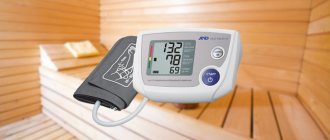Many people suffering from high blood pressure are sure that running is contraindicated for them, as is doing any other sport. However, doctors deny this: playing sports, including running, helps a person cope with the disease.
Sergei Berdnikov, a cardiologist and specialist in echocardiography and functional diagnostics at the European Medical Center, helped us figure out how to run without harming ourselves.
There is a statement that if a person constantly moves during the day, walks 5-6 km to do household chores, takes children or grandchildren to kindergartens and schools, then this load is absolutely enough for health. Unfortunately, this is the most common misconception.
Only periodic maintenance of a high pulse, achieved during sports activities, can improve the elasticity of the arteries, reduce the “stiffness” of the heart muscle, and reduce peripheral insulin resistance. Insulin resistance is a metabolic disorder in which the concentration of glucose in the blood increases and a number of diseases flourish, problems with blood vessels and excess weight appear.
From the standpoint of evidence-based medicine, regular running is an effective tool for reducing and normalizing blood pressure and preventing diabetes.
Is it possible to run with high blood pressure?
It is possible and even necessary. Regular aerobic exercise has a beneficial effect on the course of arterial hypertension and reduces the risk of cardiovascular diseases.
The validity of this statement is confirmed by many studies. One of them belongs to Harvard University doctor Ralph Paffenbarger. The study included 17,000 men with similar demographic characteristics. It was found that those who lost less than 500 kcal per week during exercise had the highest mortality rate. Those who lost 500 to 1,000 calories per week during exercise had a 22% lower mortality rate.
The results of those who lost up to 3,500 kcal per week were even more impressive. Their mortality rate was 54% lower. In this case, intensive training included running, swimming, handball, cycling, and skiing.
Training plans for marathon and half marathon. and start preparing today.
Physical activity is absolutely necessary for people with high blood pressure, but it is important not to overdo it. Activity should not lead to excessive strain on the body's resources. Abuse of training leads to the opposite result - general health worsens, systolic-diastolic blood pressure increases, and arrhythmogenic potential increases.
This statement is perfectly illustrated by another study from Harvard University, which compared the life expectancy of elite athletes, average athletes and those who did not play sports at all. It turned out that it is the untitled athletes who live longer.
Running rules
Hypertension should structure your workouts according to your schedule. Once started, it should no longer stop them. Only constant moderate loads will give a lasting positive effect.
Here are simple guidelines to follow:
- It is recommended to run in the morning or evening at the same time. This way the body gets used to the load faster.
- In the case of evening workouts, it is better to finish them 2 hours before bedtime. The body must come into balance.
- In the morning before training, it is not recommended to have breakfast: drink a cup of herbal decoction to avoid discomfort.
- Clothing should be loose, waterproof and windproof. The ideal solution is a tracksuit with a membrane. In cold weather, you should wear thermal underwear.
- Shoes should be comfortable. A soft flexible sole is preferred.
- If you feel unwell, tired or have a racing heart, stop exercising. Don't stop abruptly. Slow down your pace first and then start walking. This should take 2-5 minutes.
- If blood pressure is very high, exercise should be prohibited. This applies to patients with stage 3 hypertension.
- You should exercise every day, regardless of the weather. You are allowed to take a day off once a week.
- Heart rate monitoring is mandatory. For this, the formula is used: 210 - the number of complete years. If the calculated value is exceeded, stop running.
- It is important to breathe properly while running. Inhale with your nose for “one-two”, exhale with your mouth for “three”.
- After training you should rest. It is best to lie down for 30 minutes. It is recommended to place a cushion under your feet: it will help improve blood circulation.
- It is recommended to eat food after a morning workout 30-40 minutes later. Breakfast should be healthy and tasty. In the evening after training, let's drink a glass of kefir or yogurt.
- Measure your blood pressure before each workout. Repeat the measurement after completing your workout. The last measurement should be taken after 30 minutes. In case of deviations, stop training and consult a therapist.
The main rule of training: after finishing a run, a person with hypertension should feel a surge of energy. His mood improves.
How to start correctly
Choose pleasant weather for your first exercise. The mood should be positive. The place for running should be chosen away from highways, workplaces, and industrial zones. The park is the perfect place.
With high blood pressure, a gradual increase in load is required. Before training, do a few light strokes and bends.
The first trip should not exceed 10-15 minutes. The pace is relaxed. At the end of the session, a light walk is recommended to restore your breathing.
Training time should be increased by 5 minutes every week. The maximum permissible training duration is 30-40 minutes.
When running with excess pressure, jerking and heavy loads exceeding the specified duration are prohibited.
Features of running in the gym
Sometimes people with hypertension cannot jog outside. Working out at the gym can help. The advantages of this method: the athlete’s condition is controlled by the instructor and the selection of dosed loads.
- Before training, warm up for 30 minutes;
- when warming up, it is not recommended to tilt your head down for a long time;
- the first exercise should be performed with minimal load;
- after training you need to rest for 30 minutes;
- it is important to monitor your pulse; if your heart rate exceeds the target value, stop training;
- breathe evenly;
- It is recommended to limit your water intake during exercise: this can lead to a sharp increase in blood pressure.
Before choosing a gym, you should ask if there is an individual trainer who can create a schedule for hypertension classes.
What happens to blood pressure while running?
Exercise can increase blood pressure, but the effect is usually temporary - blood pressure should gradually return to normal after exercise.
According to Centers for Disease Control and Prevention guidelines, a blood pressure of less than 120/80 mmHg is considered normal. These are systolic pressure (first number) and diastolic pressure (second number). Systolic blood pressure is a measure of the pressure in the blood vessels when the heart beats. Physical exercise increases it.
Diastolic blood pressure is a measure of the pressure in blood vessels between heartbeats. It should not change significantly during training. If it changes, consult your doctor.
It is difficult to say definitively what is considered healthy blood pressure after exercise, since blood pressure varies from case to case. A normal level for one person may be a sign of a problem for another.
However, in general, high blood pressure after a rest period of up to two hours after exercise includes any value above 140/90 mmHg, and low blood pressure after exercise includes any value below 90/60 mmHg.
Causes of increased pressure
Pressure is a physical characteristic that shows the functioning of different body systems. First, let's figure out why such a disease as hypertension occurs.
Stroke volume
First, stroke volume (SV)—the amount of blood that fills the vessels in one heartbeat—may increase. Here the systolic pressure (top number) increases.
There are 2 main reasons for increased SV : heart + amount of fluid.
Heart
The functioning of the heart muscle is disrupted: the rhythm is disrupted, the wall hypertrophies, contractility decreases due to a previous heart attack.
Liquid quantity
Fluid excretion is impaired due to consumption of large amounts of salt, kidney problems, and thyroid diseases.
Vessels
Atherosclerotic plaques reduce the elasticity of blood vessels.
The main cause of atherosclerosis is increased cholesterol intake.
In addition, blood vessels can narrow due to poor kidney function and the release of stress hormones. Any metabolic disorder is the cause of pressure destabilization.
All these factors more often lead to an increase in systolic + diastolic pressure (upper + lower).
How to start running with hypertension
The following tips will be useful to people who know for sure that they have high blood pressure, but decide to go jogging.
People suffering from hypertension who have not previously exercised should understand that they need to start small. The duration of the first lesson is no more than 10-15 minutes.
People with hypertension probably already have a tonometer at home - a device for measuring blood pressure. If not, it’s worth buying one, because it’s important to measure your blood pressure before running. It is generally accepted that blood pressure is above 160/100 mmHg. at rest is a contraindication for starting training.
To make your workouts not only safe, but also effective, you should also invest in a sports watch and a chest-mounted heart rate monitor to monitor your heart rate. They will help you train in safe heart rate zones and collect the necessary information about your training.
Before starting training, it is optimal to undergo testing on a treadmill with gas analysis and lactate determination - treadmill test. It allows you to individually calculate pulse zones and helps identify patients with coronary heart disease or heart failure for whom planned exercise may be contraindicated.
Is there a need for exercise if you have hypertension?
Hypertension occurs due to the narrowing of blood vessels and the appearance of oxygen starvation in the cells. Negative emotions, excess weight, bad habits and a sedentary lifestyle contribute to vasoconstriction, after which blood moves through the arteries at increased speed. This raises blood pressure and increases the production of adrenaline, which negatively affects the functioning of the body’s cardiac system.
Physical activity, including sports, household chores, and walking, allows blood vessels to expand naturally. The blood restores its usual pattern of movement, which stabilizes blood pressure. The maximum positive effect is achieved during physical activity with emphasis on the legs.
Almost 25% of all capillaries in the human body are concentrated in the lower extremities. When walking or running, the capillaries open almost completely and fill with oxygen. The leg muscles serve as a kind of cardiac motor, helping the heart pump blood at a reflex level. The energy costs of the heart are reduced, thereby stabilizing the condition of the hypertensive patient.
Join the
Club of Former Hypertensive Patients
, download gymnastics that has already helped hundreds of thousands of people overcome pressure surges and hypertension.
Get the most current and correct information about problems related to blood pressure, osteochondrosis, atherosclerosis, ask your questions to Dr. Shishonin and just communicate.
Rules for running for hypertension and permissible loads
- During initial training - the first 2-3 weeks - you should stick to jogging, that is, running at a slow pace at a low heart rate.
- Training begins with a slight warm-up of the body muscles. This is not stretching, but dynamic light gymnastics. You can do squats, bends back and forth, and circular movements.
- It is also important not to start the jog itself right from the entrance. It is recommended to walk briskly, then do a warm-up, and then start jogging.
- After 2-3 weeks of regular training, it is permissible to increase the pace and duration of running. Over time, you can increase your running time to the optimum - this is 40-60 minutes per workout.
- The number of workouts per week varies and depends on concomitant diseases and general physical fitness. It is unlikely that two workouts a week will be effective; it is advisable to train 3-5 times. Even if you can’t devote enough time to training, then 10-15 minutes of activity is preferable to no activity. And here it doesn’t matter what it will be - ellipse, bicycle, running or strength training with your own weight.
- Remember that running always increases your appetite. But eat after your workout because running right after eating is not recommended. If you are very hungry, you can eat some fruit or drink tea with sugar to avoid stomach discomfort.
Read on topic: Running on an empty stomach
The benefits of moderate running
Any treatment method is aimed at improving the patient's condition. It's the same with running. One-time irregular jogging does not stabilize the condition of a patient with hypertension. Only systematic exercises on a set schedule can help.
- strengthening the walls of blood vessels;
- delivery of oxygenated blood to muscles and tissues;
- increasing the lumen of blood vessels;
- Reduced resistance of the walls of blood vessels (they become more elastic, pressure decreases).
All this prevents hypertensive crises. Regular jogging may reduce the amount of medication you take. It happens that a person with hypertension begins to cope without pills (in the initial stage of the disease).
To enhance the therapeutic effect, it is recommended to supplement running with Nordic walking and hiking. Sports activities should be diversified by swimming.
The group often includes people with hypertension. Communication distracts from problems and helps improve mental state.
What else is important to know if you are just starting to run?
Before you start training, it is important to choose the right running shoes. Unfortunately, modern city residents are accustomed to very comfortable shoes that weaken the muscles of the feet, and many develop flat feet of varying severity.
For normal pronation, shoes will fit without any adjustments. If there are deviations from the norm, a correction is necessary to bring your pronation closer to normal. For this purpose, special compensating sole mechanisms are created. Their task is to protect the runner from injuries, unnecessary overexertion and make running more comfortable. Neglecting the choice of shoes and running technique leads to inflammation of the Achilles tendon, plantar fasciitis and a forced long break from sports activity.
You also need to purchase special clothing. It should be light and not hinder movement, protect from bad weather. If you have hypertension, avoid wearing overly warm clothes to avoid overheating. Thick sweaters and lined pants will make you uncomfortable during training, and overheating can lead to dehydration and cause blood pressure instability both during and after exercise.
If you are planning to take up running, we recommend reading this great guide for beginners: How to start running and not quit. In it we talk about the specifics of training, choosing clothes and shoes, nutrition, breathing and other nuances that will help you get the most benefit from running.









